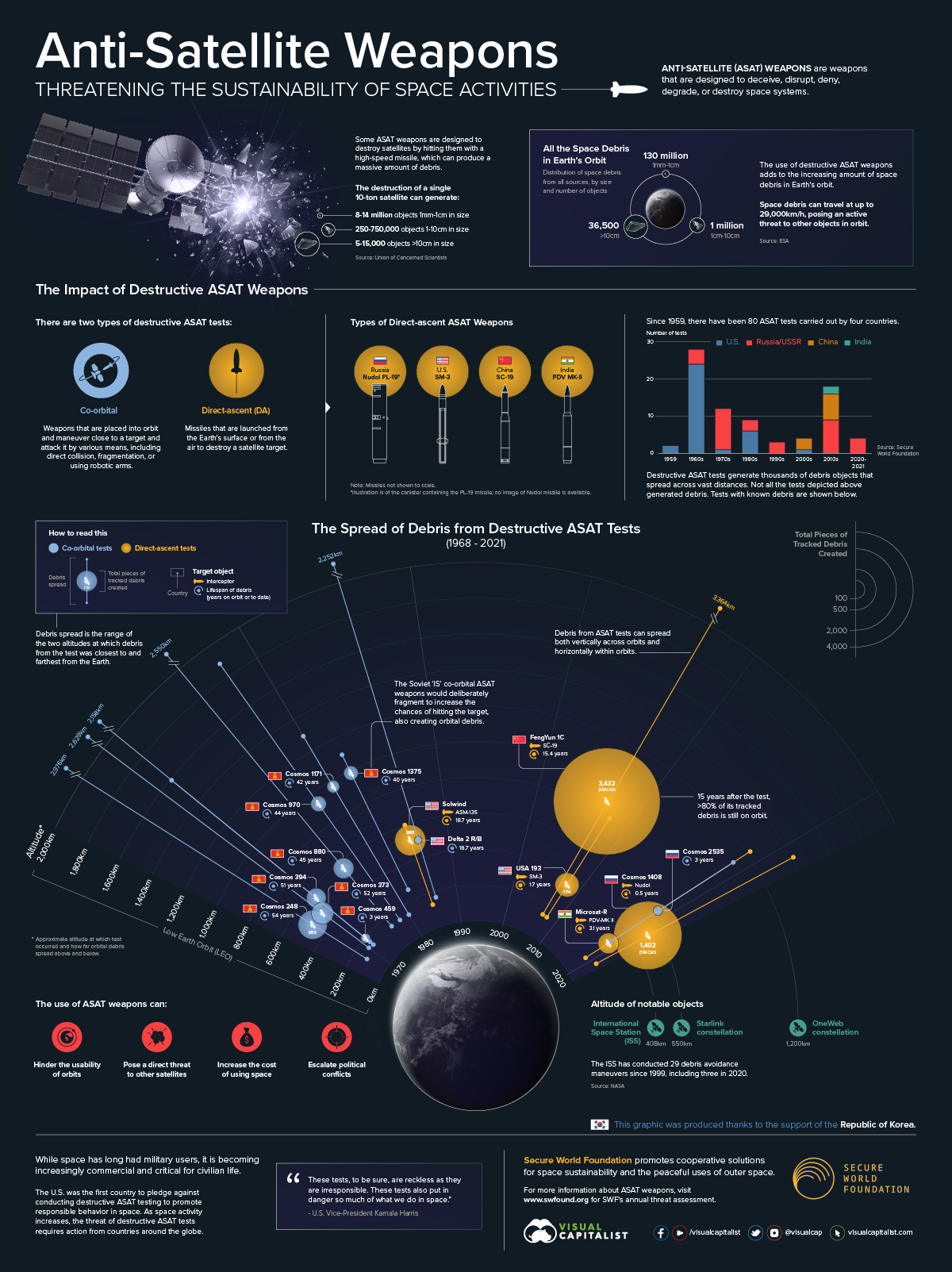Anti-Satellite Weapons: Threatening the Future of Space Activities
The following content is sponsored by Secure World Foundation.
What Are Anti-Satellite Weapons?
At any given moment, there are thousands of satellites orbiting the Earth for commercial, civil, strategic, and military reasons.
Due to the importance of certain satellites for national security, countries have developed anti-satellite (ASAT) weapons that can be used to incapacitate or destroy satellites in orbit.
While some ASAT weapons use non-destructive means like cyberattacks or lasers to impair satellites, the destructive types often rely on high-speed physical collision to shatter satellites, creating negative repercussions for the space environment.
The above infographic from Secure World Foundation explains how destructive ASAT testing is hindering outer space and adding to the increasing space debris in Earth’s orbits.
The Impact of Destructive Anti-Satellite Weapons
When destructive ASAT weapons collide with satellites, they can create thousands to millions of pieces of debris that can orbit the Earth for decades at extremely high speeds.
According to the Union of Concerned Scientists, the destruction of a single 10-ton satellite can generate:
- 8 to 14 million debris pieces between 1mm and 1cm in size
- 250,000 to 750,000 debris pieces between 1cm and 10cm
- 5,000 to 15,000 debris pieces greater than 10cm
The debris from destructive ASAT testing adds to the 8,800 metric tons of space debris that’s already floating around in space. Since space debris can travel at speeds up to 29,000km/h (roughly 8km/s), even millimeter-sized fragments are massive threats to other objects in orbit.
In fact, the International Space Station (ISS) has conducted 29 debris avoidance maneuvers since 1999, which involve rerouting to avoid potential collisions with debris pieces.
The History and Aftermath of Destructive ASAT Tests
Historically, just four countries—Russia (formerly the USSR), China, the U.S., and India—have successfully used destructive ASAT weapons of two types:
- Co-orbital: Weapons that are placed into orbit and maneuver close to a target and attack it by various means, including direct collision, fragmentation, or using robotic arms.
- Direct-ascent: Missiles that are launched from the Earth’s surface or from air to destroy a satellite target in orbit.
Since 1968, these four countries have successfully conducted 15 destructive ASAT tests, creating thousands of pieces of tracked debris that spread across vast distances.
| Year | Country | Weapon type | Number of tracked debris pieces created | Spread of debris | Lifespan of debris (years on orbit) |
|---|---|---|---|---|---|
| 1968 | USSR | Co-orbital | 253 | 109km-2,976km | 54 |
| 1970 | USSR | Co-orbital | 147 | 137km-2,629km | 52 |
| 1971 | USSR | Co-orbital | 117 | 152km-2,158km | 51 |
| 1971 | USSR | Co-orbital | 28 | 126km-1,603km | 3 |
| 1976 | USSR | Co-orbital | 127 | 126km-2,550km | 45 |
| 1978 | USSR | Co-orbital | 72 | 126km-1,898km | 44 |
| 1980 | USSR | Co-orbital | 48 | 122km-1,304km | 42 |
| 1982 | USSR | Co-orbital | 62 | 247km-1,110km | 40 |
| 1985 | 🇺🇸 U.S. | Direct-ascent | 285 | 120km-615km | 19 |
| 1986 | 🇺🇸 U.S. | Co-orbital | 18 | 152km-2,252km | 1 |
| 2007 | 🇨🇳 China | Direct-ascent | 3,432 | 125km-3,364km | 15 |
| 2008 | 🇺🇸 U.S. | Direct-ascent | 174 | 123km-803km | 2 |
| 2019 | 🇷🇺 Russia | Co-orbital | 27 | 279km-1,121km | 3 |
| 2019 | 🇮🇳 India | Direct-ascent | 130 | 115km-1,233km | 3 |
| 2021 | 🇷🇺Russia | Direct-ascent | 1,402 | 148km-1,423km | 0.5 |
*The spread of debris refers to the two altitudes at which debris pieces from the test were closest to and farthest from the Earth’s surface, known as perigee and apogee, respectively.
Between 1961 and 1982, the USSR launched a series of satellites for various missions, including the testing of its co-orbital ASAT weapons under the Istrebitel Sputnikov (meaning “destroyer of satellites”) program. As of 2022—40 to 50 years after these tests—some of their tracked debris is still orbiting the Earth.
China’s destruction of the FengYun 1C weather satellite in 2007 was by far the most-destructive ASAT test in terms of debris creation. The collision generated over 3,400 pieces of tracked debris, and was the first successful direct-ascent ASAT test since 1985.
In November 2021, Russia made the headlines for a destructive direct-ascent test responsible for around 1,400 new pieces of tracked debris, along with hundreds of thousands of smaller fragments. The consequences of the test prompted calls for a global ban on destructive ASAT testing.
It’s also important to note that debris fragments from these tests are not only orbiting the Earth but also spreading far from the altitude where these tests occurred. For example, some fragments from China’s 2007 test reached more than 3,000km beyond the Earth’s surface.
The Call to Ban Destructive Testing
The debris from deliberate satellite destruction is dangerous and uncontrollable, threatening other satellites and spacecraft. As more satellites and human spacecraft enter outer space, preventing further debris creation is critical to protecting the long-term sustainability of space activities.
Following Russia’s recent test, the U.S. was the first nation to commit not to conduct destructive ASAT tests, urging other nations to follow suit.
“These tests, to be sure, are reckless as they are irresponsible.”
U.S. Vice President Kamala Harris
>> Secure World Foundation promotes cooperative solutions for space sustainability and the peaceful uses of outer space.
-

 Sponsored3 years ago
Sponsored3 years agoMore Than Precious: Silver’s Role in the New Energy Era (Part 3 of 3)
Long known as a precious metal, silver in solar and EV technologies will redefine its role and importance to a greener economy.
-

 Sponsored7 years ago
Sponsored7 years agoThe History and Evolution of the Video Games Market
Everything from Pong to the rise of mobile gaming and AR/VR. Learn about the $100 billion video games market in this giant infographic.
-

 Sponsored8 years ago
Sponsored8 years agoThe Extraordinary Raw Materials in an iPhone 6s
Over 700 million iPhones have now been sold, but the iPhone would not exist if it were not for the raw materials that make the technology...
-

 Sponsored8 years ago
Sponsored8 years agoThe Industrial Internet, and How It’s Revolutionizing Mining
The convergence of the global industrial sector with big data and the internet of things, or the Industrial Internet, will revolutionize how mining works.



